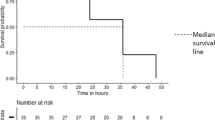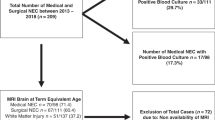Abstract
Objective
To evaluate the effect of withholding feeds during transfusion on transfusion associated acute gut injury (TRAGI).
Study design
Data were collected on 125 preterm infants before and after the practice of withholding feeds for 12–24 h during transfusion was instituted. Logistic regression was used to examine effects of withholding feeds on TRAGI rates.
Results
A total of 19 (15%) infants developed NEC; 6/19 (32%) had TRAGI. Postnatal hydrocortisone use was associated with TRAGI (OR 8.97; 95% CI 1.17–68.46, p = 0.034). There was no difference in NEC rates (15.8 vs. 14.7%) and the proportions (22.2 vs. 40%) of TRAGI in the two time periods before and after instituting the standardized feeding regimen and practice of holding feeds during transfusion.
Conclusion
No significant decrease was noted in the rates of TRAGI after feeds were withheld during transfusion. Further studies are warranted to explore the relationship between feeds during transfusion and NEC.
This is a preview of subscription content, access via your institution
Access options
Subscribe to this journal
Receive 12 print issues and online access
$259.00 per year
only $21.58 per issue
Buy this article
- Purchase on Springer Link
- Instant access to full article PDF
Prices may be subject to local taxes which are calculated during checkout
Similar content being viewed by others
References
Stoll BJ, Hansen NI, Bell EF, Walsh MC, Carlo WA, Shankaran S, et al. Trends in care practices, morbidity, and mortality of extremely preterm neonates, 1993–2012. JAMA. 2015;314:1039–51.
Fitzgibbons SC, Ching Y, Yu D, Carpenter J, Kenny M, Weldon C, et al. Mortality of necrotizing enterocolitis expressed by birth weight categories. J Pediatr Surg. 2009;44:1072–5.
Jasani B, Patole S. Standardized feeding regimen for reducing necrotizing enterocolitis in preterm infants: an updated systematic review. J Perinatol. 2017;37:827–33.
Mohamed A, Shah PS. Transfusion associated necrotizing enterocolitis: a meta-analysis of observational data. Pediatrics. 2012;129:529–40.
Josephson CD, Wesolowski A, Bao G, Sola-Visner MC, Dudell G, Castillejo MI, et al. Do red cell transfusions increase the risk of necrotizing enterocolitis in premature infants? J Pediatr. 2010;157:972–8.
Bak SY, Lee S, Park JH, Park KH, Jeon JH. Analysis of the association between necrotizing enterocolitis and transfusion of red blood cell in very low birth weight preterm infants. Korean J Pediatr. 2013;56:112–5.
Stritzke AI, Smyth J, Synnes A, Lee SK, Shah PS. Transfusion-associated necrotising enterocolitis in neonates. Arch Dis Child Fetal Neonatal Ed. 2013;98:F10–F14.
Singh R, Visintainer PF, Frantz ID 3rd, Shah BL, Meyer KM, Favila SA, et al. Association of necrotizing enterocolitis with anemia and packed red blood cell transfusions in preterm infants. J Perinatol. 2011;31:176–82.
Mally P, Golombek SG, Mishra R, Nigam S, Mohandas K, Depalhma H, et al. Association of necrotizing enterocolitis with elective packed red blood cell transfusions in stable, growing, premature neonates. Am J Perinatol. 2006;23:451–8.
Blau J, Calo JM, Dozor D, Sutton M, Alpan G, La Gamma EF. Transfusion-related acute gut injury: necrotizing enterocolitis in very low birth weight neonates after packed red blood cell transfusion. J Pediatr. 2011;158:403–9.
Paul DA, Mackley A, Novitsky A, Zhao Y, Brooks A, Locke RG. Increased odds of necrotizing enterocolitis after transfusion of red blood cells in premature infants. Pediatrics. 2011;127:635–41.
AlFaleh K, Al-Jebreen A, Baqays A, Al-Hallali A, Bedaiwi K, Al-Balahi N, et al. Association of packed red blood cell transfusion and necrotizing enterocolitis in very low birth weight infants. J Neonatal Perinat Med. 2014;7:193–8.
Sood BG, Rambhatla A, Thomas R, Chen X. Decreased hazard of necrotizing enterocolitis in preterm neonates receiving red cell transfusions. J Matern Fetal Neonatal Med. 2016;29:737–44.
Elbaid MT, Harsono M, Talati Aj, Dhanireddy R. Effect of birth weight on the association between necrotising enterocolitis and red blood cell transfusions in ≤1500 g infants. BMJ Open. 2013;3:e003823.
Marin T, Josephson CD, Kosmetatos N, Higgins M, Moore JE. Feeding preterm infants during red blood cell transfusion is associated with a decline in postprandial mesenteric oxygenation. J Pediatr. 2014;165:464–71.
El-Dib M, Narang S, Lee E, Massaro AN, Aly H. Red blood cell transfusion, feeding and necrotizing enterocolitis in preterm infants. J Perinatol. 2011;31:183–7.
Derienzo C, Smith PB, Tanaka D, Bandarenko N, Campbell ML, Herman A, et al. Feeding practices and other risk factors for developing transfusion-associated necrotizing enterocolitis. Early Hum Dev. 2014;90:237–40.
Doty M, Wade C, Farr J, Gomezcoello VC, Martin G, Nasr T. Feeding during blood transfusions and the association with necrotizing enterocolitis. Am J Perinatol. 2016;33:882–6.
Ohls RK, Ehrenkranz RA, Wright LL, et al. Effects of early erythropoietin therapy on the transfusion requirements of preterm infants below 1250 grams birth weight: a multicenter, randomized, controlled trial. Pediatrics. 2001;108:934–42.
Papile LA, Burstein J, Burstein R, Koffler H. Incidence and evolution of subependymal and intraventricular hemorrhage: a study of infants with birth weights less than 1500 g. J Pediatr. 1978;92:529–34.
Walsh MC, Kliegman RM. Necrotizing enterocolitis: treatment based on staging criteria. Pediatr Clin N Am. 1986;33:179–201.
Patel RM, Knezevic A, Shenvi N, Hinkes M, Keene S, Roback JD, et al. Association of red blood cell transfusion, anemia, and necrotizing enterocolitis in very low-birth-weight infants. JAMA. 2016;315:889–97.
Kirsten GF, Smith J, Pieper C, Bird A, Wessels G, Riphagen S, et al. The necessity for T-cryptantigen activation screening in babies with necrotising enterocolitis. S Afr Med J. 1996;86:546–8.
Klein RL, Novak RW, Novak PE. T-cryptantigen exposure in neonatal necrotizing enterocolitis. J Pediatr Surg. 1986;21:1155–8.
Hall N, Ong EG, Ade-Ajayi N, Fasoli L, Ververidis M, Kiely EM, et al. T cryptantigen activation is associated with advanced necrotizing enterocolitis. J Pediatr Surg. 2002;37:791–3.
Perciaccante JV, Young TE. Necrotizing Enterocolitis associated with packed red blood cell transfusions in premature neonates. E-Pas. 2008;5839:5838.
Talavera MM, Bixler G, Cozzi C, Dail J, Miller RR, McClead R Jr, et al. Quality improvement initiative to reduce the necrotizing enterocolitis rate in premature infants. Pediatrics. 2016;137:e20151119. pii
Jasani B, Rao S, Patole S. Withholding feeds and transfusion-associated necrotizing enterocolitis in preterm infants: a systematic review. Adv Nutr. 2017;8:764–9.
Krimmel GA, Baker R, Yanowitz TD. Blood transfusion alters the superior mesenteric artery blood flow velocity response to feeding in premature infants. Am J Perinatol. 2009;26:99–105.
Corvaglia L, Martini S, Battistini B, Rucci P, Aceti A, Faldella G. Bolus vs. continuous feeding: effects on splanchnic and cerebral tissue oxygenation in healthy preterm infants. Pediatr Res. 2014;76:81–85.
Dave V, Brion LP, Campbell DE, Scheiner M, Raab C, Nafday SM. Splanchnic tissue oxygenation, but not brain tissue oxygenation,increases after feeds in stable preterm neonates tolerating full bolus orogastric feeding. J Perinatol. 2009;29:213–8.
Author contributions
MB: Conceptualized and designed the study. Collected and analyzed data. Wrote the first draft of manuscript and reviewed and revised the manuscript. ML: Conceptualized and designed the study, collected data, reviewed and approved the manuscript. AH: Collected data, reviewed and approved the manuscript. GN: Conceptualized and designed the study. Analyzed data. Critically reviewed, revised and approved the manuscript.
Author information
Authors and Affiliations
Corresponding author
Ethics declarations
Conflict of interest
The authors declare that they have no conflict of interest.
Additional information
Publisher’s note: Springer Nature remains neutral with regard to jurisdictional claims in published maps and institutional affiliations.
Rights and permissions
About this article
Cite this article
Bajaj, M., Lulic-Botica, M., Hanson, A. et al. Feeding during transfusion and the risk of necrotizing enterocolitis in preterm infants. J Perinatol 39, 540–546 (2019). https://doi.org/10.1038/s41372-019-0328-7
Received:
Revised:
Accepted:
Published:
Issue Date:
DOI: https://doi.org/10.1038/s41372-019-0328-7
This article is cited by
-
Transfusions and neurodevelopmental outcomes in extremely low gestation neonates: to transfuse or not to transfuse, that is the question…
Pediatric Research (2021)
-
Anemia, transfusion, feeding, and racial factors in the pathogenesis of transfusion-associated necrotizing enterocolitis
Journal of Perinatology (2019)
-
Response to Dr. Nair
Journal of Perinatology (2019)



